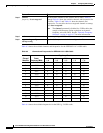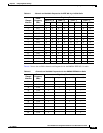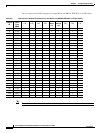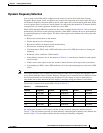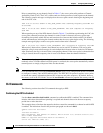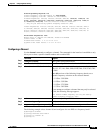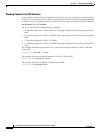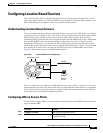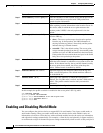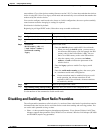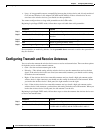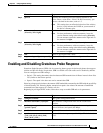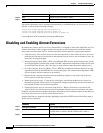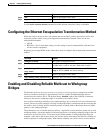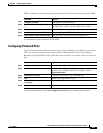
6-22
Cisco IOS Software Configuration Guide for Cisco Aironet Access Points
OL-11350-01
Chapter 6 Configuring Radio Settings
Enabling and Disabling World Mode
In this example, the profile southside is enabled on the access point’s 802.11g radio:
ap# configure terminal
ap(config)# dot11 lbs southside
ap(dot11-lbs)# server-address 10.91.105.90 port 1066
ap(dot11-lbs)# interface dot11 0
ap(dot11-lbs)# exit
Enabling and Disabling World Mode
You can configure the wireless device to support 802.11d world mode, Cisco legacy world mode, or
world mode roaming. When you enable world mode, the wireless device adds channel carrier set
information to its beacon. Client devices with world mode enabled receive the carrier set information
and adjust their settings automatically. For example, a client device used primarily in Japan could rely
on world mode to adjust its channel and power settings automatically when it travels to Italy and joins a
Step 3
server-address ip-address port port Enter the IP address of the location server and the port on the
server to which the access point sends UDP packets that
contain location information.
Step 4
method {rssi} (Optional) Select the location method that the access point uses
when reporting location information to the location server. In
this release, rssi (in which the access point measures the
location packet’s RSSI) is the only option and is also the
default.
Step 5
packet-type {short | extended} (Optional) Select the packet type that the access point accepts
from the LBS tag.
• short—The access point accepts short location packets
from the tag. In short packets, the LBS information is
missing from the tag packet’s frame body and the packet
indicates the tag’s transmit channel.
• extended—This is the default setting. The access point
accepts extended packets from the tag. An extended packet
contains two bytes of LBS information in the frame body.
If the packet does not contain those two bytes in the frame
body, the access point drops the packet.
Step 6
channel-match (Optional) Specifies that the LBS packet sent by the tag must
match the radio channel on which the access point receives the
packet. If the channel used by the tag and the channel used by
the access point do not match, the access point drops the
packet. Channel match is enabled by default.
Step 7
multicast-address mac-address (Optional) Specifies the multicast address that the tag uses
when it sends LBS packets. The default multicast address is
01:40:96:00:00:10.
Step 8
interface dot11 { 0 | 1 } Specify the radio interface on which this LBS profile is
enabled. The 2.4-GHz radio is radio 0, and the 5-GHz radio is
radio 1. The profile remains inactive until you enter this
command.
Step 9
exit Return to global configuration mode.
Command Purpose



